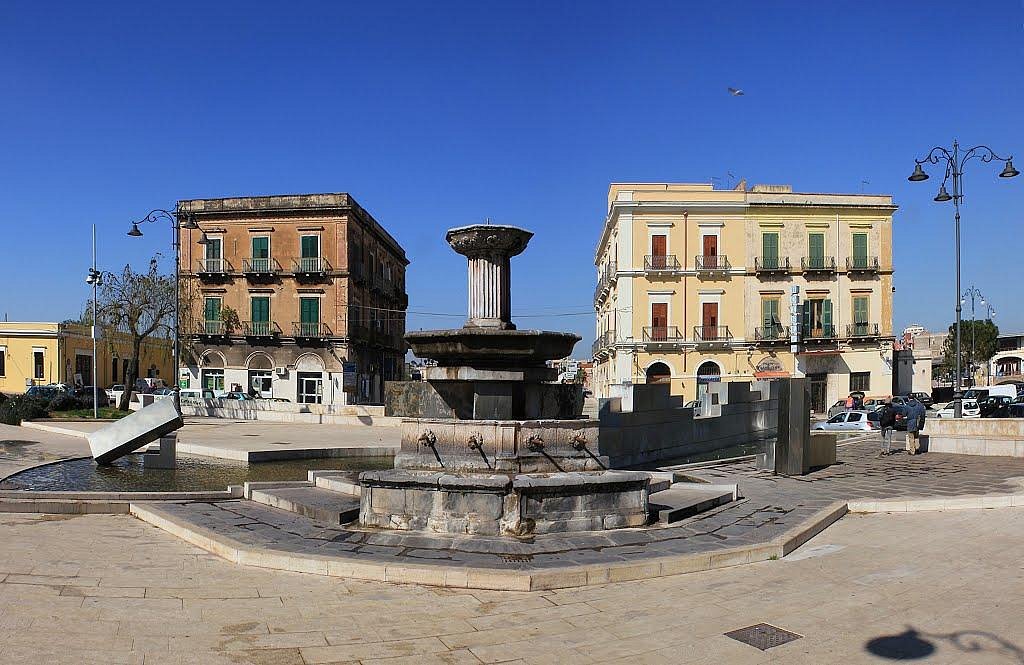Piazza Fontana
Piazza Fontana (fountain square)
Urban planning

Place of meeting and commercial exchanges, Piazza Fontana, formerly called "Piazza Maggiore" or "Piazza Grande", arose thanks to the Byzantine fill of the 10th century. In medieval times, in fact, the Emperor Nicephorus II Phocas gave way to an impressive reorganization of the urban spaces of the city of Taranto, expanding them with a sea fill.
In this area of the city was located the so-called “Citadel”, a fortified area built several times starting from 1404, the period from which Raimondello Orsini del Balzo chose Taranto as the seat of his vast principality. The so-called "Citadel" was demolished several times between 1884 and 1893. The medieval square was equipped with a fountain and drinking troughs for the animals and could be considered the commercial center of the city and the fulcrum of city life.
The ancient public fountain, which was fed by the Triglio Aqueduct, was built at the behest of Charles V of Habsburg and from the date of its inauguration (1543) gave the new name to the urban space. In 1861, the ancient work decorated with the Austrian coat of arms, cherubs seated on dolphins, tritons and statues of pagan gods, was replaced with a much simpler and less decorated structure signed by the architect de Florio.
In 1992 the square underwent important changes and also the space occupied by the nineteenth-century fountain was completely redesigned by Nicola Carrino, bringing it to its current state. Archaeological excavations have returned the evidence of the important past of the urban space by re-emerging the foundations and portions of the north and east wall of the quadrangular tower built by Raimondello Orsini del Balzo, as well as other military works erected to guard the access to the city.

Place of meeting and commercial exchanges, Piazza Fontana, formerly called "Piazza Maggiore" or "Piazza Grande", arose thanks to the Byzantine fill of the 10th century. In medieval times, in fact, the Emperor Nicephorus II Phocas gave way to an impressive reorganization of the urban spaces of the city of Taranto, expanding them with a sea fill.
In this area of the city was located the so-called “Citadel”, a fortified area built several times starting from 1404, the period from which Raimondello Orsini del Balzo chose Taranto as the seat of his vast principality. The so-called "Citadel" was demolished several times between 1884 and 1893. The medieval square was equipped with a fountain and drinking troughs for the animals and could be considered the commercial center of the city and the fulcrum of city life.
The ancient public fountain, which was fed by the Triglio Aqueduct, was built at the behest of Charles V of Habsburg and from the date of its inauguration (1543) gave the new name to the urban space. In 1861, the ancient work decorated with the Austrian coat of arms, cherubs seated on dolphins, tritons and statues of pagan gods, was replaced with a much simpler and less decorated structure signed by the architect de Florio.
In 1992 the square underwent important changes and also the space occupied by the nineteenth-century fountain was completely redesigned by Nicola Carrino, bringing it to its current state. Archaeological excavations have returned the evidence of the important past of the urban space by re-emerging the foundations and portions of the north and east wall of the quadrangular tower built by Raimondello Orsini del Balzo, as well as other military works erected to guard the access to the city.
Step back into the past directly from your smartphone
Do you want to go back to 1400 to see the Tower of Raimondello Orsini and the Stone Bridge?
Tourist route
Discover the recommended tourist route to visit Palazzo Pantaleo and the other points of historical and cultural interest in the immediate vicinity
Sea Experiences
If you want to live Taranto at 360 °, do not miss the experiences available! Do you want to reach the dolphins with the Jonian Dolphin Conservation or just spend a day on a sailing boat? Discover Taranto Capitale di Mare
Piazza Fontana (fountain square)
Urban planning

Place of meeting and commercial exchanges, Piazza Fontana, formerly called "Piazza Maggiore" or "Piazza Grande", arose thanks to the Byzantine fill of the 10th century. In medieval times, in fact, the Emperor Nicephorus II Phocas gave way to an impressive reorganization of the urban spaces of the city of Taranto, expanding them with a sea fill.
In this area of the city was located the so-called “Citadel”, a fortified area built several times starting from 1404, the period from which Raimondello Orsini del Balzo chose Taranto as the seat of his vast principality. The so-called "Citadel" was demolished several times between 1884 and 1893. The medieval square was equipped with a fountain and drinking troughs for the animals and could be considered the commercial center of the city and the fulcrum of city life.
The ancient public fountain, which was fed by the Triglio Aqueduct, was built at the behest of Charles V of Habsburg and from the date of its inauguration (1543) gave the new name to the urban space. In 1861, the ancient work decorated with the Austrian coat of arms, cherubs seated on dolphins, tritons and statues of pagan gods, was replaced with a much simpler and less decorated structure signed by the architect de Florio.
In 1992 the square underwent important changes and also the space occupied by the nineteenth-century fountain was completely redesigned by Nicola Carrino, bringing it to its current state. Archaeological excavations have returned the evidence of the important past of the urban space by re-emerging the foundations and portions of the north and east wall of the quadrangular tower built by Raimondello Orsini del Balzo, as well as other military works erected to guard the access to the city.
contacts
useful information
accessible
- Sempre accessibile